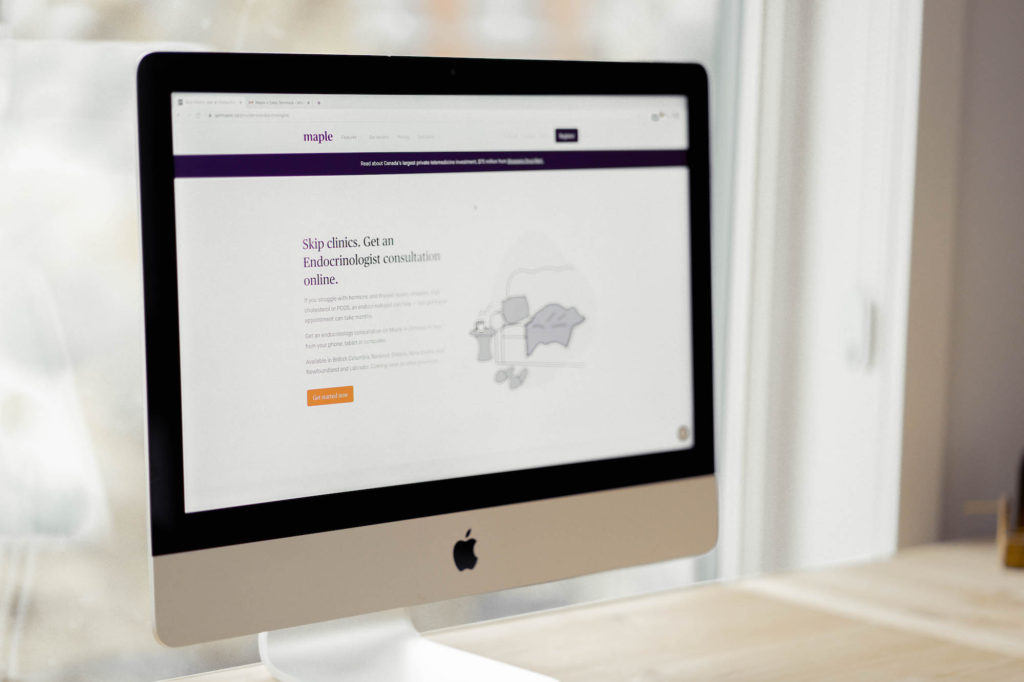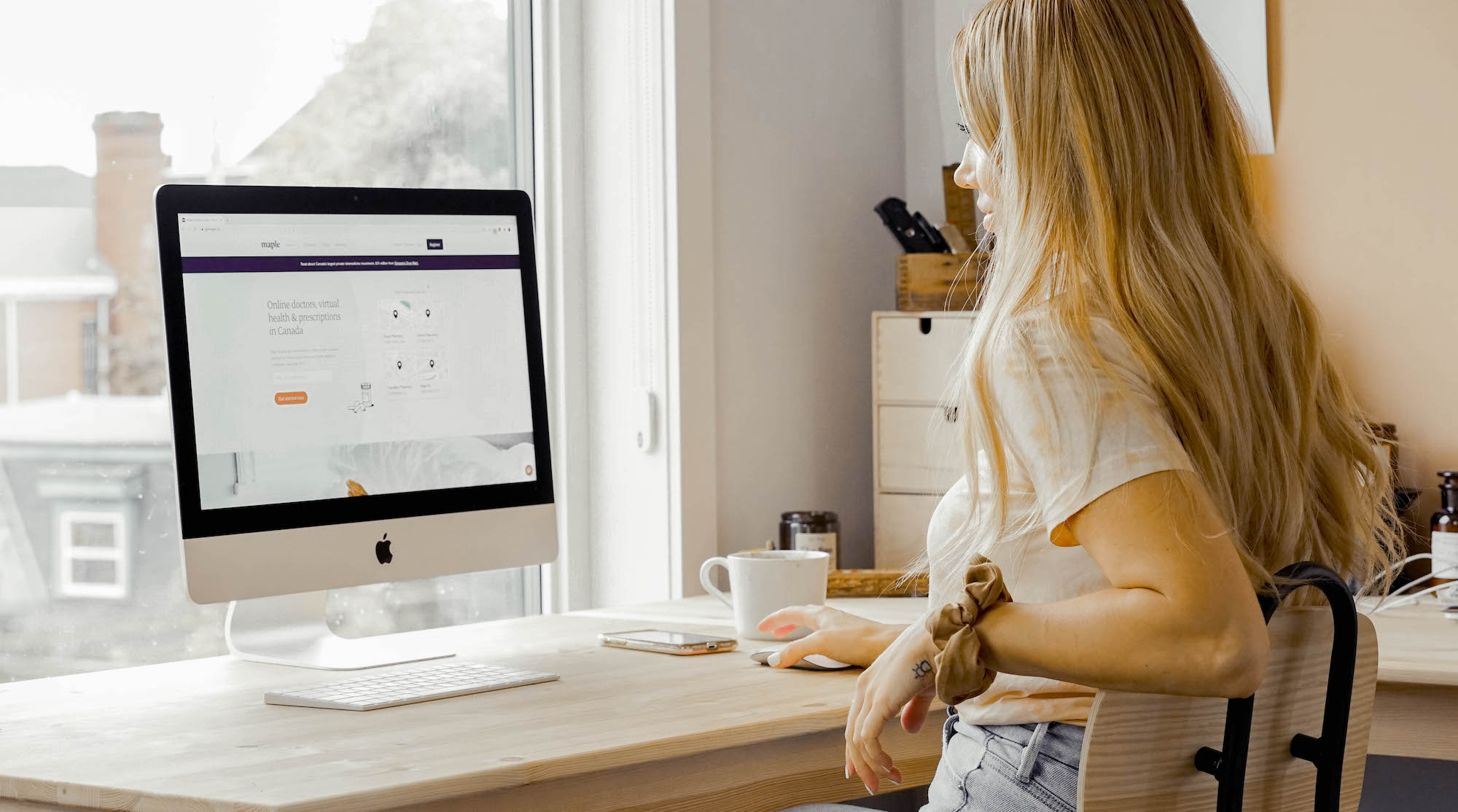This post was made possible by Maple. Maple connects you with Canadian healthcare providers in minutes from your phone, tablet or computer, any time 24/7 via secure text, audio or video call.
September is PCOS (Polycystic Ovary Syndrome) awareness month. And it’s been quite a while since I’ve spoken on this topic, as someone who has the condition. If you’re lucky to not have PCOS, you might be wondering what the heck it is.
Well, it’s a health problem that affects 1 in 10 women. Yes, that many of us.
The cause is still unknown, but researchers hypothesize that it could be caused by high levels of androgens and/or high levels of insulin.
PCOS can cause ovarian cysts, missed or irregular periods, acne, male-patterned facial hair growth, hair loss, thinning hair, weight gain, infertility, and is also linked to increased risks for heart disease, high cholesterol, anxiety and depression, high blood pressure, and diabetes. In fact, 50% of women with PCOS develop pre-diabetes or Type 2 Diabetes by the age of 40.
And there is no cure.
That being said, not every single one of the above symptoms are experienced by everyone with the condition. Myself being one of them. And there are many ways you can manage your PCOS and even improve your symptoms, even if it feels like a losing battle.
I have minimized a lot of my symptoms over the years, by implementing a few key factors into my routine. It can be hard to keep it front-of-mind as a busy business owner, but I’ve made it work.
The following is what’s worked for me, and I am not a doctor. This is not medical advice. You should always seek advice from your doctor before implementing a new health routine or treatment.
1) I Try to Stay Mindful of What I Eat
This is easier said than done of course, and I mess this one up a lot. But when I was 21, I started to become more mindful of what I was putting into my body, and it drastically helped my symptoms. I went from getting my period every 3 or 4 months, to getting it every 30 days – 60 days. And now at 30 years old, I get it pretty much like clockwork. I also rarely ever get cysts anymore.
When I say I’ve become more mindful, I mostly mean reducing sugar, processed foods, and caffeine. Insulin resistance plagues some women with PCOS, so being careful to not overload on sugar is essential. Again, easier said than done, and I often find myself having to do no-sugar challenges in order to kick sugar again sometimes. Lowering your sugar intake also does big things for balancing your energy levels, which is essential if you’re a busy business owner with a lot on the go.
Another ingredient I’ve found makes a difference is cinnamon. Adding cinnamon to your diet helps to balance blood sugar and makes fat cells more responsive to insulin. For more about that and other food recommendations for PCOS, check out this valuable article by Laurence Annez.
I have also found some supplements to be beneficial in addition to my diet.
For some years, I was on a medication called spironolactone. Spironolactone is a potassium-sparing diuretic used to treat many things, such as high blood pressure, heart failure, and conditions that cause the body to make too much aldosterone.
I was originally put on it to help treat my acne and male-patterned facial hair growth, but I ended up finding it wasn’t working as well as I wanted, and I also knew that perhaps I should be focused on a more well-rounded approach instead of just treating the symptoms. I also found the medication was sometimes making my chest and heart feel “fluttery”, and I knew that couldn’t be a good sign.
Enter, supplements.
These days my routine consists of fish oil, vitamin D, probiotics, and saw palmetto. Though I have tried many other supplements for PCOS as well, including inositol.
The most helpful for me, by far, has been saw palmetto. Now again, I am not a doctor, this is not medical advice, this is just what’s worked for me.
Saw palmetto noticeably improved my skin, it helped my hair grow longer and healthier than ever, and I’m pretty sure it’s also helped keep my periods very regular. There is still a lack of research on the use of saw palmetto in women, but I will say that the affects I’ve noticed for my PCOS symptoms have been significant.
2) I do my Best to Stay Active
Regular exercise can help to lower insulin levels and also keep blood sugar levels low. And of course, we all know the many, many, many other benefits of exercise.
My top tip when it comes to getting active, is to not force yourself to do an activity you don’t enjoy.
For example, there were many years where I felt like I was a weirdo because I didn’t like 5-10km runs like most of my peers. In fact, I tried to adopt running like this for over five years without success of it sticking. The problem was that I just simply didn’t enjoy it!
These days I find myself leaning more towards hiking, bouldering, and skiing.

So if hitting the gym isn’t for you, play around and find something you do enjoy! There are so many possibilities, and with PCOS it is crucial to incorporate movement into your life.
3) I Maintain a Healthy Weight
Again, this can be another tough one for those of us with PCOS, but with the right diet, exercise, and mindset combination, it’s more than possible.
Right before I became more knowledgeable about food and nutrition, my weight had been creeping up. I am 5’7” and I had just topped 160 lbs, which made my BMI 25, which technically classified me as overweight.
Not only was I not happy with how I looked and felt, but the more weight I put on, the more I noticed my PCOS symptoms flared up. This is when my periods were the least frequent, when my acne and hair growth was at its worst, and when I also tested as pre-diabetic.
I got my act together and really focused hard on treating my body and mind better. And within months, not only did I lose 20lbs, but my periods regulated, my acne improved, and my blood sugar levels returned to normal.
Yes, it can be hard when you’re busy. Whether you’re a business owner, mom, caretaker, or anyone these days, really (bring me someone who isn’t busy). But if you have PCOS, you have to make your health a priority, or else things will only get worse and worse.
4) I Got Diagnosed and Seek Medical Help When Needed
Getting diagnosed with PCOS can be incredibly difficult. A lot of physicians are still not up to snuff on their knowledge, and the symptoms of PCOS can be mistaken for other causes and conditions. I started having symptoms at 15, but I wasn’t diagnosed until I was 20. And many women go undiagnosed until they try to get pregnant and have fertility issues.
While getting diagnosed can definitely be a headache, did you know that if you’re in Canada, you can now you can see an endocrinologist online, within 24 hours?
Yep. It’s true.
And they can even help to diagnose you, send lab requisitions, and write prescriptions.
So what is this magical service you ask?
It’s called Maple.

And it’s a service I’ve personally used many times over the last couple years when I haven’t been able to see my family doctor fast enough, or when I need to access other medical care on the fly.
How does it work?
It’s pretty simple! You register, describe your symptoms, you then get connected with a doctor online, and then you can get advice, treatment, diagnosis, and prescriptions right through the app.
Yep that’s right — you can see a doctor, or specialist even, from the comfort or your home, or when you’re on the go, on your computer, tablet, or cell phone.
And guess what? You don’t even need a referral to see a specialist. Which can save you WEEKS or even MONTHS of time waiting.
So I know what you must be thinking… “Okay Caley. This sounds amazing. But it must be expensive?”
The cost might actually surprise you!
To see a general practitioner, it’s:
- CAD $49/visit Weekdays (7am – midnight ET)
- CAD $79/visit Weekends and Holidays (7am – midnight ET)
- CAD $99/visit Overnight (midnight ET – 6:59am)
And to see an endocrinologist, it’s CAD $195 per visit.
In Canada we’re so lucky to have public health care, which relieves a huge financial burden. But this can also mean SUPER long wait times. So if you do have the means to be able to pay a small fee, I definitely think Maple is worth checking out.
And Maple isn’t exclusive the general health issues or endocrinology health problems — they have so many different types of specialists you can access online quickly. Some of these include dermatologists, oncologists, and psychiatrists. To see a full list of the specialists you can access through Maple, click here.
So what happens if you log onto Maple and it ends up being a situation where the physician or specialist tells you to go to the emergency room? Well, this happened to me earlier this year when I thought I had an ovarian cyst rupturing. If you do find yourself in this situation, the doctor simply advises you to go to the emergency room, your session ends, and you are not charged by Maple. Pretty neat, eh?
To learn more about Maple and to sign up, click here.


+ show Comments
- Hide Comments
add a comment